NORTH WALES COAST RAILWAY:NOTICE BOARD
Rheilffordd arfordir gogledd Cymru: Hysbysfwrdd
06 June 2016
 Last issue
Last issue Archive
Archive Tweet
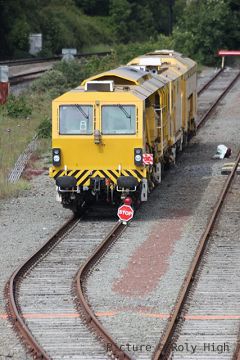
Tweets by @NWrail1
Contributions and comments are encouraged: see the Contributions Page
This list may be out of date if you are reading an archived issue. For full information visit our Calendar page.
June 2016
Monday 6 June Steam Dreams THE CAMBRIAN COAST EXPRESS (Day 2 of 4)
Tuesday 7 June Steam Dreams THE CAMBRIAN COAST EXPRESS (Day 3 of 4)
Wednesday 8 June Steam Dreams THE CAMBRIAN COAST EXPRESS (Day 4 of 4) Bangor - Paddington. Steam loco 60103 Flying Scotsman: Chester - Wrexham - Hereford - Bristol Parkway - Paddington
Wednesday 15 June Steam Dreams THE EMERALD ISLE EXPLORER (Day 1 of 9) London Euston-Holyhead Steam loco 60103 Flying Scotsman: Euston-Holyhead.
July 2016
Sunday 24 July Railway Touring Company THE NORTH WALES COAST EXPRESS Liverpool-Holyhead (WCRC) Steam loco 45690 or 46100: Liverpool - Chester - Holyhead and return
Tuesday 26 July Railway Touring Company THE WELSH MOUNTAINEER Preston - Blaenau Ffestiniog . Steam loco 45305 or 48151: Preston - Chester - Blaenau Ffestiniog and return
August 2016
Sunday 21 August Railway Touring Company THE NORTH WALES COAST EXPRESS Crewe - Manchester - Holyhead (WCRC) Steam loco 45690 or 46115: Manchester - Chester - Holyhead and return
September 2016
Sunday 4 September Railway Touring Company THE NORTH WALES COAST EXPRESS Crewe - Manchester - Holyhead (WCRC) Steam loco 45690 or 46115: Manchester - Chester - Holyhead and return
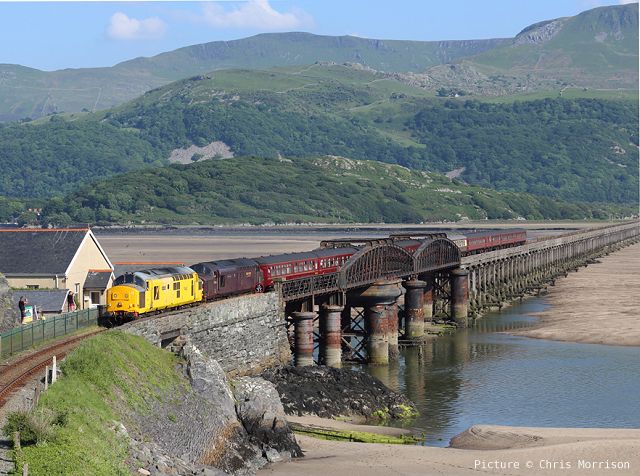
The classic view of Barmouth bridge with the 'Cambrian Coast Express' excursion on 5 June: see report below. Picture by Chris Morrison.
Cambrian Coast Express
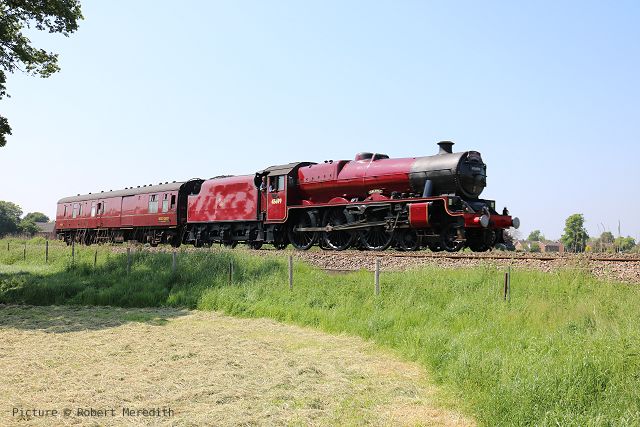
The first leg of Steam Dreams' four-day railway holiday starting on 5 June was a train (1Z45) from London Paddington (dep. 08:31) to Pwllheli (arr 19:18) where the participants would repair to a hotel. The train had been advertised to feature Flying Scotsman between London and Shrewsbury, but in the event, 45699 Galatea was used: Robert Meredith photographed it near Nantwich on its way home with support coach.
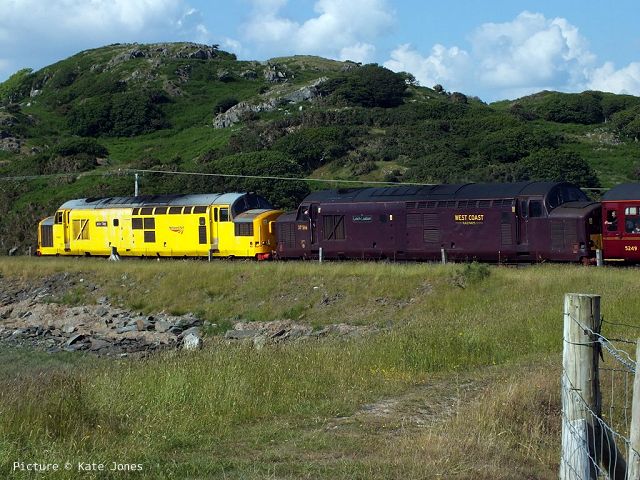
West of Shrewsbury, ERTMS signalling-fitted 97 304 John Tiley and West Coast Railways 37 516 Loch Laidon.
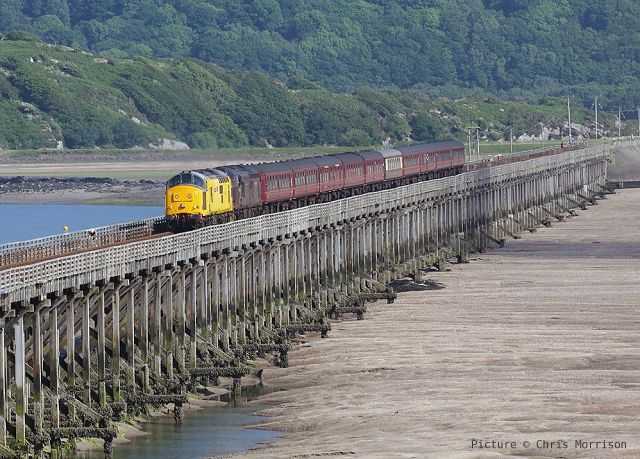
Heading across Barmouth Bridge (Chris Morrison).
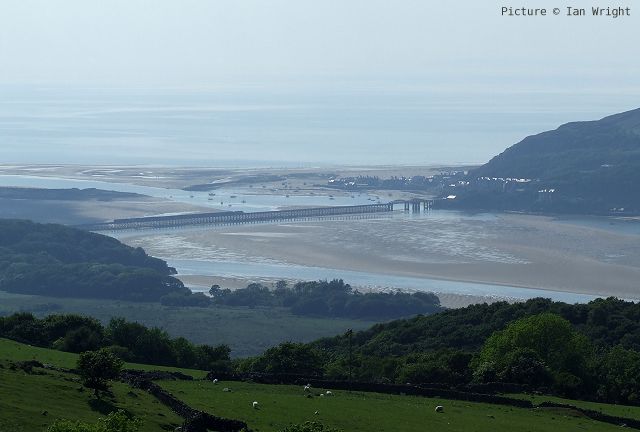
As seen from the Cregennan Lakes on a slightly hazy day (Ian Wright)
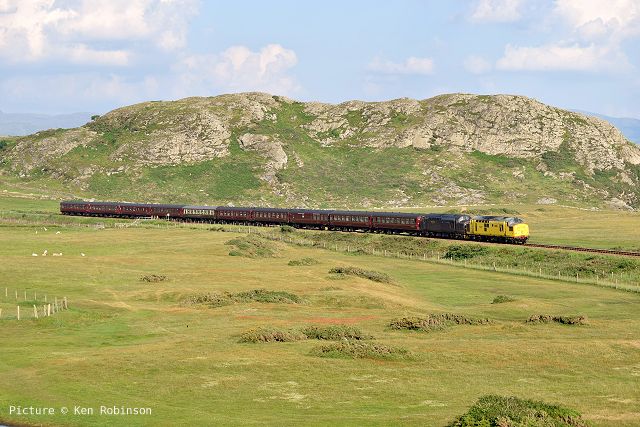
Near the site of Black Rock Halt between Porthmadog and Criccieth (Ken Robinson).
The previous day, a run by Flying Scotsman from London was - yet again - disrupted by trespassing photographers straying from a foot crossing, despite appeals by Network Rail and the National Railway Museum for people to behave, and attempts to make the run semi-secret by the removal of details of the run from online sources. The train, and a Cross-Country Class 170 heading the other way came to a stand after being warned by a signaller, and the crews of both trains had to shout at them to clear the line: This link and this one are pictures on Twitter from the two trains.
The train returns - steam hauled - along the North Wales Coast line on 8 June, but it seems we are not allowed to tell you about it.
Pretty in Pink - and friends
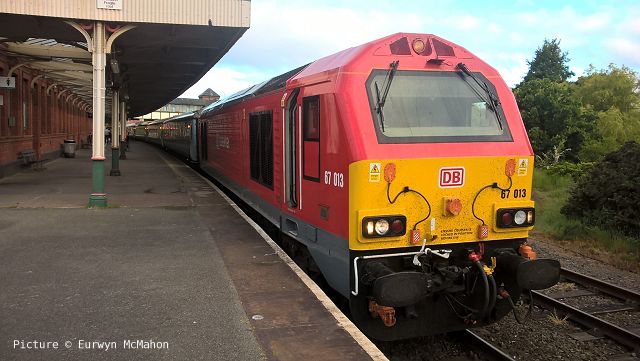
67 013 certainly adds a dash of colour to the early morning railway scene. Eurwyn McMahon photographed the visitor on 1 June working train 1V91 05:33 Holyhead - Cardiff at Llandudno Junction ...
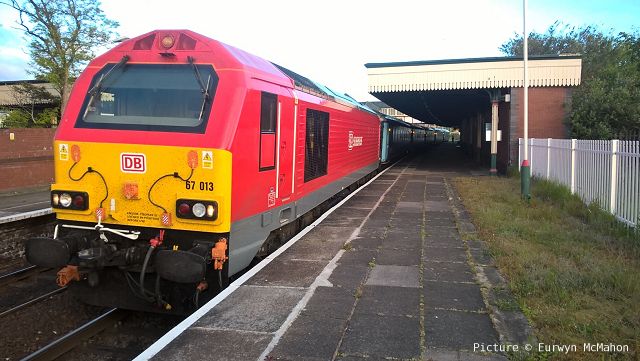
... and Colwyn Bay.

On 3 June, 67 013 had been replaced by 67 001, back in traffic with new wheels and a few other 'shiny bits' on the bogies and underframe (Eurwyn McMahon).
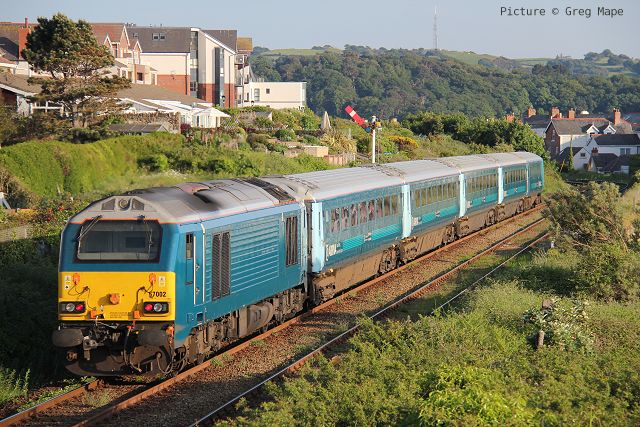
67 002 pushes the evening Llandudno - Crewe train through Deganwy on 3 June (Greg Mape).
Loco headlamp question answered
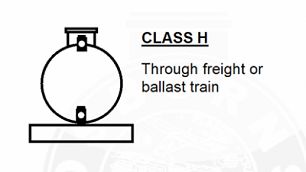 Thanks to all for the flood of replies about the headlamp
positions on 9F-2-10-0s as illustrated by David Pool in the last issue.
The answer relates to the implementation of 25 kV overhead
electrification on the West Coast Main Line in the 1960s. Combinations
of headlamp positions were still meant to be used to indicate to
signalmen the class of the train, and there was felt to be an
electrocution risk to anyone attempting to attach a headlamp to the top
centre position, so it was decreed that it should be re-located
downwards on any locos expected to be used 'under the wires'. It had to
off-centre to avoid other fittings; the one at footplate level was also
moved so as to maintain the pattern of lights. The 9F in David's
picture is showing 'Class H' lights (Class 8 in the alphanumeric
headcode system) as shown here.
Thanks to all for the flood of replies about the headlamp
positions on 9F-2-10-0s as illustrated by David Pool in the last issue.
The answer relates to the implementation of 25 kV overhead
electrification on the West Coast Main Line in the 1960s. Combinations
of headlamp positions were still meant to be used to indicate to
signalmen the class of the train, and there was felt to be an
electrocution risk to anyone attempting to attach a headlamp to the top
centre position, so it was decreed that it should be re-located
downwards on any locos expected to be used 'under the wires'. It had to
off-centre to avoid other fittings; the one at footplate level was also
moved so as to maintain the pattern of lights. The 9F in David's
picture is showing 'Class H' lights (Class 8 in the alphanumeric
headcode system) as shown here. 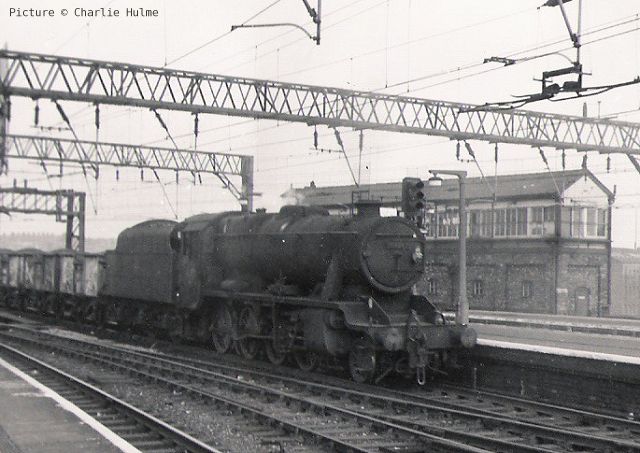
The same arrangement can be seen on the Class 8F 2-8-0 photographed by a teenage Charlie Hulme in 1966 at Stockport. This change can be a useful clue in establish an approximate date for photographs.
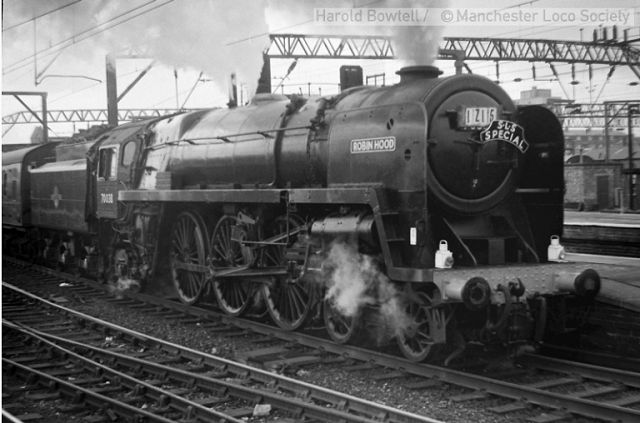
The top bracket was also often used for train headboards, many of which which were designed to match the curve of the smokebox, such as the Stephenson Locomotive Society example, photographed on 70038 Robin Hood by Harold Bowtell at Stockport on 2 July 1967. Photo by courtesy of the Manchester Locomotive Society.
Keith Stewart writes: 'In the Crewe area one day a fireman was tragically electrocuted when (force of habit?) he climbed onto the tender and swung his pick in/close to the wires. It was around this time that the small warning notices still seen on today's locomotives about this danger started appearing. If you look carefully at the photograph of 92157 you can see what may be one of these low down of the nearside smoke deflector. Another change about this time was the lowering / repositioning of headlamp brackets for the same reason.'
Tony Robinson adds: 'Not many photos exist to show it but there was another "temporary" mod carried out on the smaller 3000-gallon tenders fitted to the few remaining ex-GWR engines that ran to Crewe. This was a constricting bar fitted over the coal door on the footplate end of the tender; this horizontal bar assembly with its vertical supports was initially painted red and was supposed to prevent firemen from climbing back up into the coal space to pull the coal forward when under the wires.'
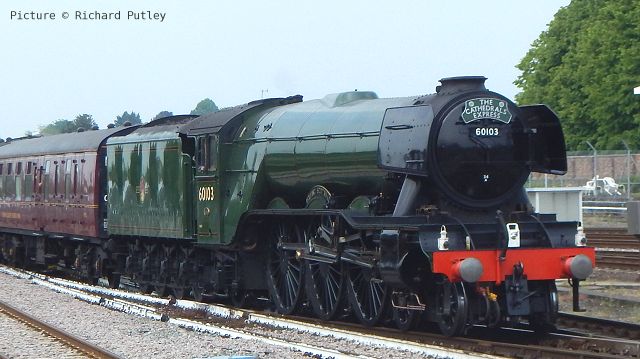
What happens today, here is Flying Scotsman herself, pictured passing Salisbury on 28 May by Richard Putley. The handrail across the front of the smokebox has been replaced by two shorter handrails and a bracket for the headboard.
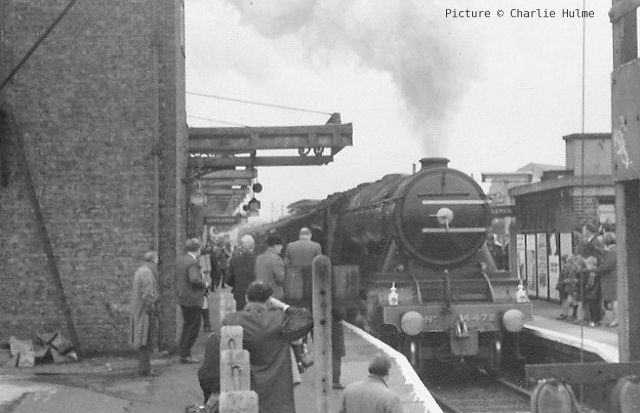
Here's another picture from ye olde black and white pile showing the original layout: taken at Finsbury Park in 1968 on the occasion when an attempt at a non-stop run from London to Edinburgh was made to celebrate the 40th anniversary of the first.
A Weekend in Wales - by Richard Heslop
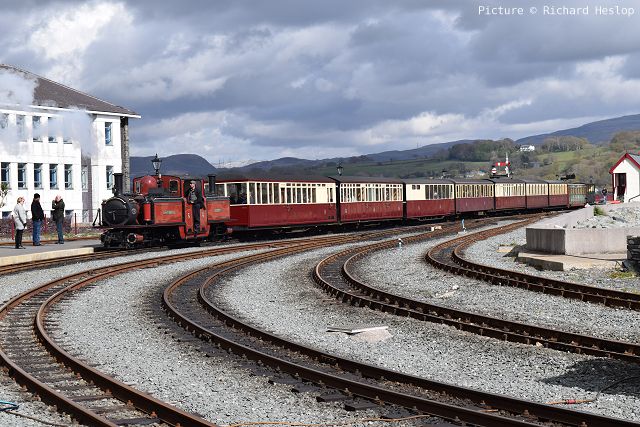
Over the Early Spring Bank Holiday my girlfriend and I had a weekend away to North Wales staying in a wonderful cottage just north of Pwllheli. I travelled up by train from Milton Keynes via Manchester and arranged to meet at Llandudno. (I should point out we live separately: me in Milton Keynes and Kath in Leeds) I arrived at the Junction to be told my lift was waiting outside. It turned out she was outside ... outside Llandudno station! It took some explaining that there were two stations called Llandudno they were in different towns. I quickly jumped on the next train down the branch (A ludicrously over-appointed class 175) which gave me a nice bonus trip along the Conwy Estuary.
As this was our proper first visit to the area (I have made flying trips for work) we looked at what might be available to fill our time. I wanted to travel on one of the great narrow gauge railways of Wales so traded a trip to Portreirion in return. Our visit there was brilliant and my lack of interest was quickly dispelled by the whimsical architecture and the ambience. That will teach me! On the way back to the cottage I suggested a cup of tea in Porthmadog where we ended up in Spooners café where we watched the comings and goings. Above: 1992-built Double Fairlie 0-4-4-0T David Lloyd George runs over the Cob into Porthmadog Harbour station.

Ffestiniog Railway 0-4-0STT No.4 Palmerston at Porthmadog. (Behind the loco is Adrian Shooter's parlour car 'Carrabasset', based on the carriages of the 2' gauge lines in Maine, USA.) Whilst there we looked at the timetables and picked the Welsh Highland Railway to Caernarfon over the Ffestiniog.
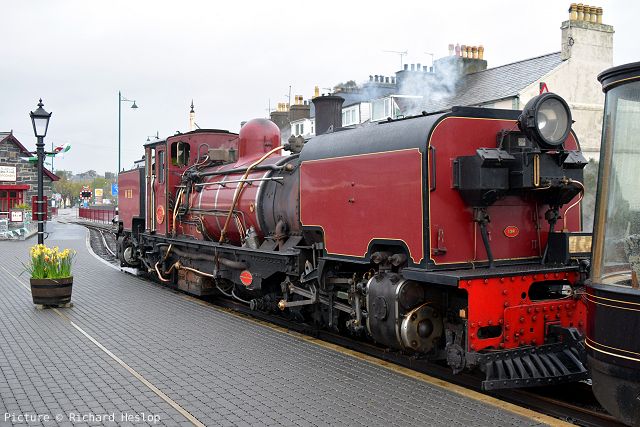
The next day dawned wet with a gray, low cloud base and as we pulled up to Porthmadog the rain was falling steadily. However, fortified by a bacon roll things were looking up so we climbed aboard our carriage and settled in for our long journey. Up front was a former South African railways Class NG G16 2-6-2+2-6-2 Garratt articulated steam locomotive. Number 138, built in Manchester by Beyer-Peacock in 1958, and resplendent in its red livery, was happily simmering away.
Within no time we were pulling out of the station and on to the street running section over Britannia Bridge. It is an odd sensation to be running along the High Street, through Wilko's car park and along someone's back lane in a train. How the FR got this approved I will never know. In no time we were over the Cambrian line on the unique flat crossing and out into the country. The cloud was really low by the time we reached Nantmor with the rain coming down hard. Sadly the view along the Aberglaslyn Pass wasn't great but it was very mysterious and Tolkien-like in the murk.
Soon Beddgelert was upon us where the train took water and the fireman built up his fire. He would need it. We were away slowly but progress was good until we reached the horseshoe section at Cwm Cloch. Here the speed fell, jogging pace, walking pace, crawling pace, snails pace, inch by inch and then almost to a stand. You could just about hear the footplate crew,: “don't stop, don't stop, don't stop” as their locomotive struggled on the greasy rails. Progress was agonisingly slow until just before the deep cutting where the beat of the locomotive became more constant and the speed increased. I bet the last thing the driver and fireman wanted was to have top stop at Meillion but stop they did and after a few anxious moments were away and steadily attacking the climb to the summit which was reached with ease before rolling to a water stop at Rhyd Ddu.
Downhill all the way now through the lovely scenery which was more visible as we had left the bad weather behind. Snowdon Ranger, Plas y Nant, Waunfawr and Tryfan Junction (must go back to visit the pub there!) didn't detain us before a longer stop at Dinas allowed us to look at the engineering yard there. Soon we were pulling down the hill towards the end of the line at Caernarfon where the grey imposing bulk of Edward I's castle towered over us.
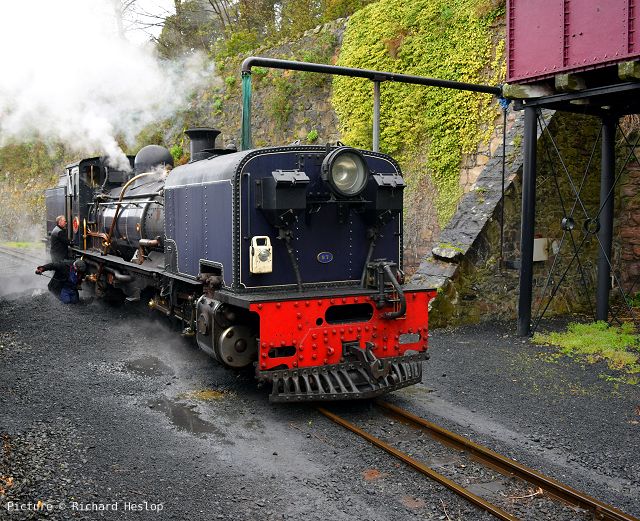
We had a couple of hours to explore a damp Caernarfon before heading back to the station where No.87 (above), another former South African Garratt, was on hand to haul us back over the hills to Porthmadog. The return journey was in slightly better weather making the scenery more enjoyable but the on-board afternoon Welsh tea of buttered bara brith, Welsh cakes and builder's tea went down a treat.
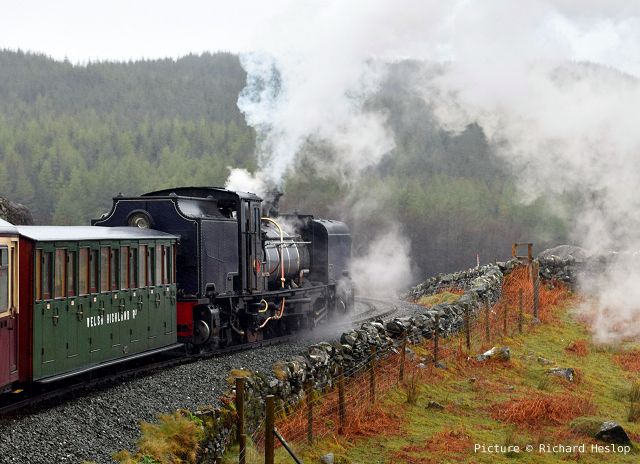
Near Snowdon Ranger.
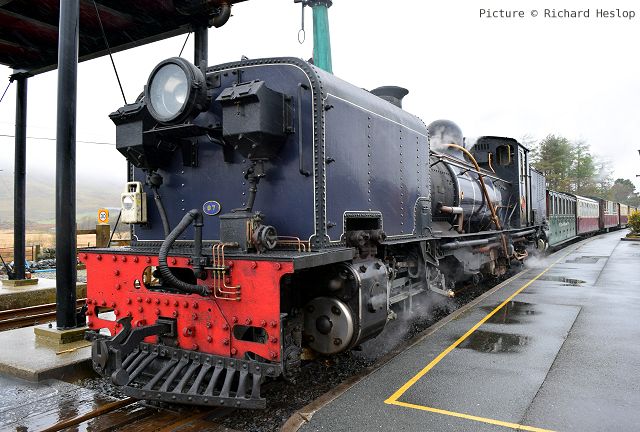
No.87 takes water (in the rain) at Rhyd Ddu.
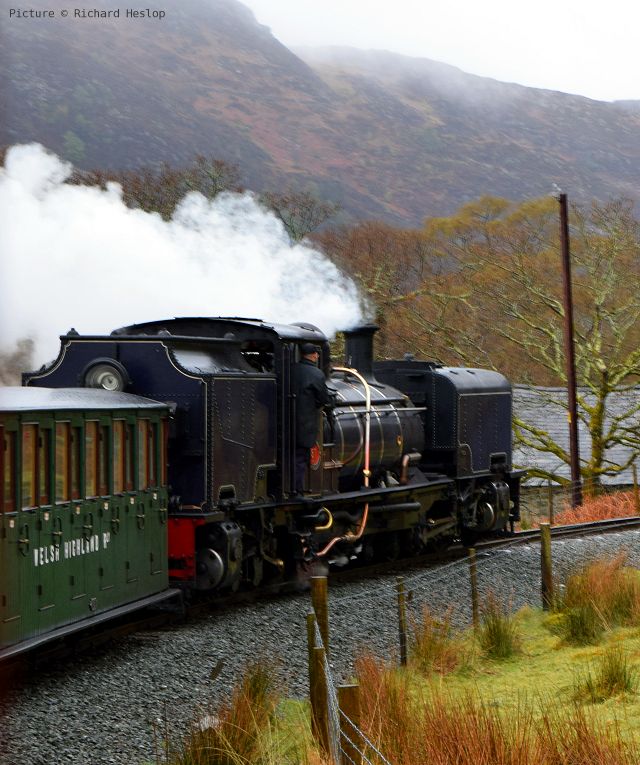
87 coasts down the 1:50 gradient from Rhyd Ddu to Beddgelert.
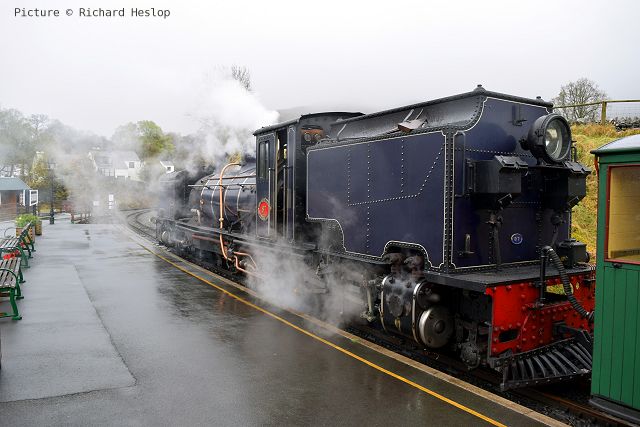
Beddgelert station.
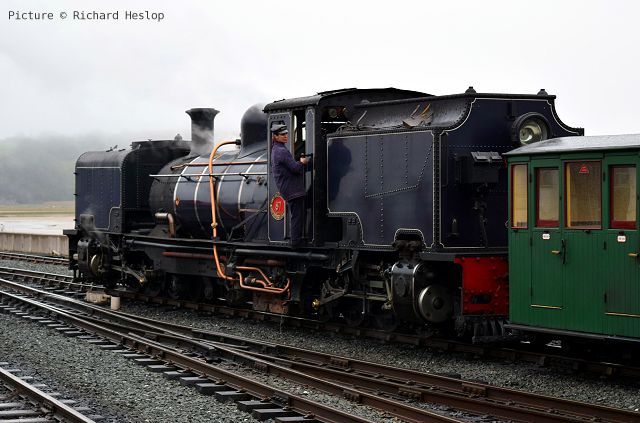
Back at Porthmadog at the end of the long journey from Caernarfon. We had a lovely day out and a journey we would love to repeat in better weather. It wasn't cheap but we had a full day out and we made the best of it despite the rain.
Miscellany
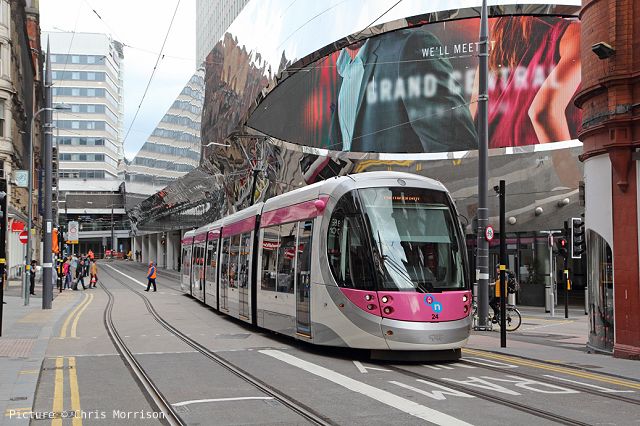
The long awaited opening of the Midland Metro to Birmingham New St happened on 30 May. CAF built No 24 has arrived at New St and is moving to the headshunt to cross tracks from the return journey to Wolverhampton (Chris Morrison).
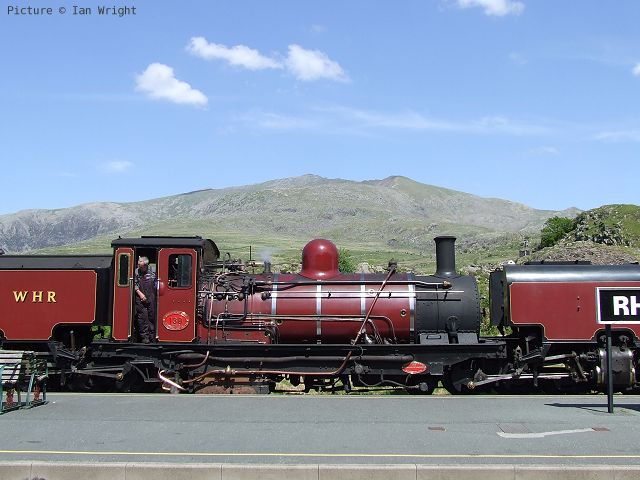
Welsh Highland Railway at Rhyd Ddu on 3 June, with a clear view to the visitor centre on Snowdon summit (Ian Wright).
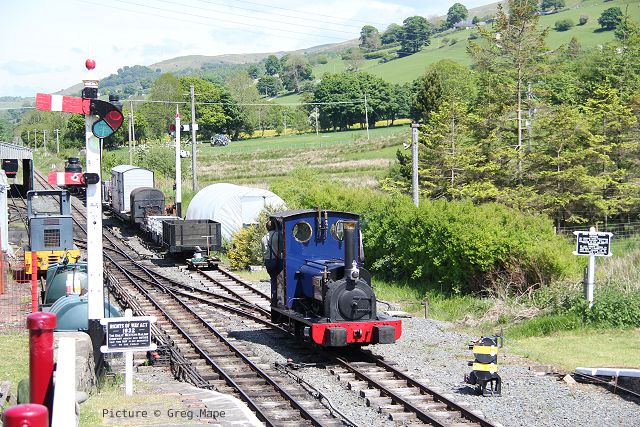
Holy War in action on the Bala Lake Railway, 31 May (Greg Mape).
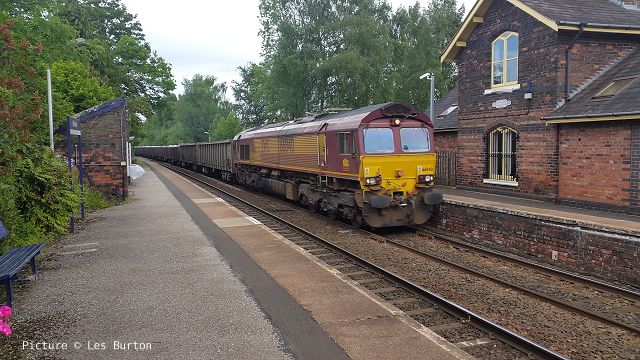
Hope Construction Materials, operators of Dowlow Quarry near Buxton, have signed a 5-year contract with DB Cargo to deliver limestone to ten terminals around England. Les Burton was at Mobberley station to record the passing of 66 040 with a train head for Bow East terminal in London.
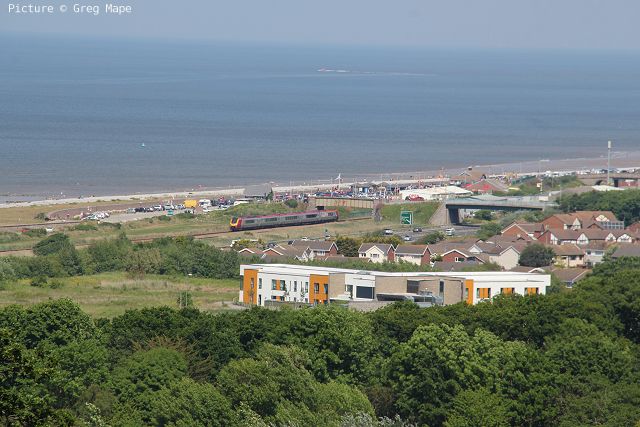
A Sunday afternoon walk by Greg Mape around the ruins of Gwrych Castle during an an open day on 5 June gave a different view of the coast line: A Voyager from Holyhead to Euston is seen passing Abergele station.
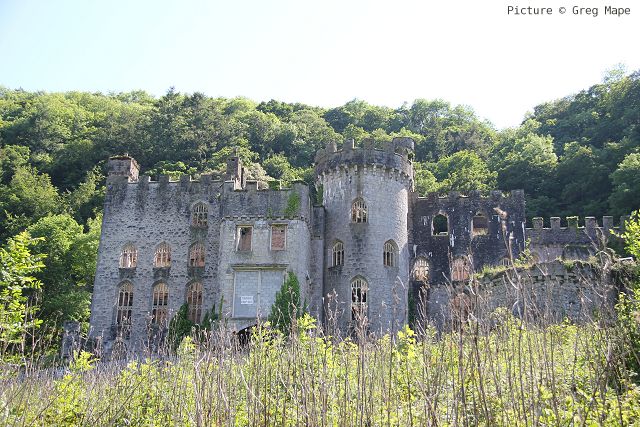
The castle, a landmark for North Wales passengers, is little more than a roofless shell after many ears of neglect and vandalism. But all is not lost: the Preservation Trust members are doing their best.
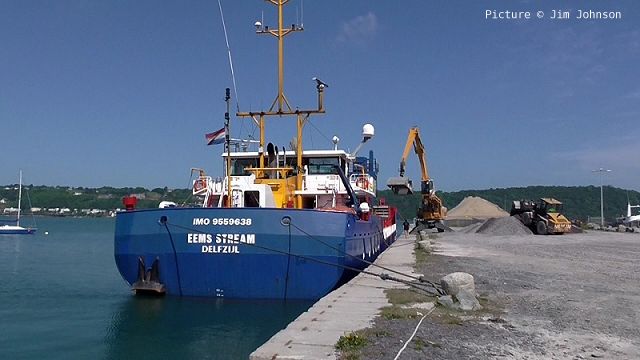
The Dutch-registered Eems Stream (Gross Tonnage 1862 t) at Port Penrhyn, Bangor, on Friday, 3 June. It had docked on the evening of 2 June, having sailed from Belfast, and spent most of the next day being loaded with slate waste at the quay. Sadly, the slate had not been brought down from Bethesda by Linda or Blanche, but by lorries (Jim Johnson).
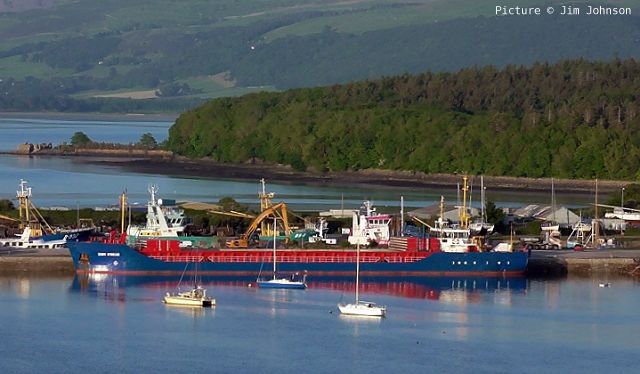
A view just before the vessel sailed on the evening tide of 3 June, bound for Rotterdam (Jim Johnson).
Evening scenes
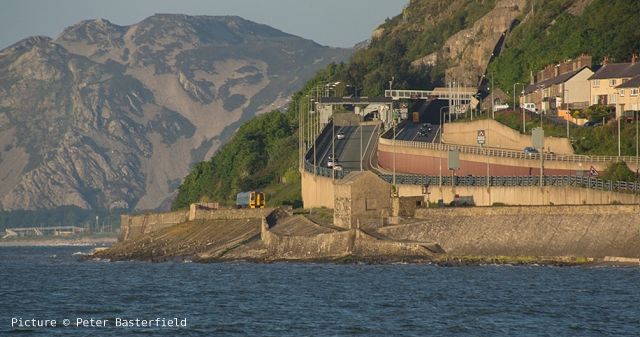
A complex array of transport infrastructure near Llanfairfechan at 20:08 on 4 June, with train 1G76 Holyhead - Birmingham New Street taking in the evening sun on the North Wales Coast (Peter Basterfield).
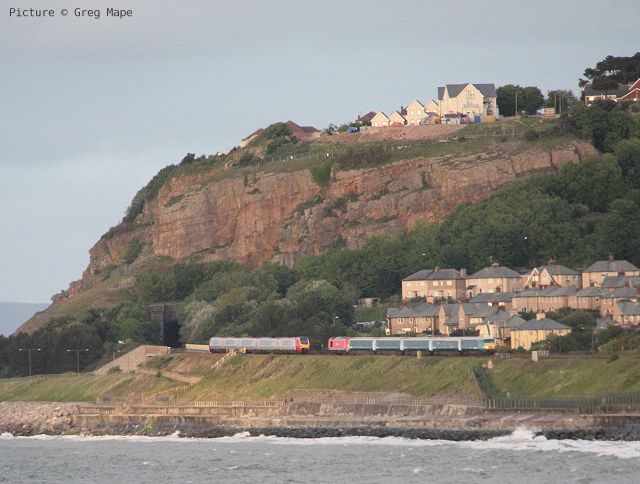
High tide near Old Colwyn on 1 June as the Cardiff - Holyhead express, powered by 67 013, passes an evening Holyhead - Birmingham Virgin Voyager (Greg Mape).
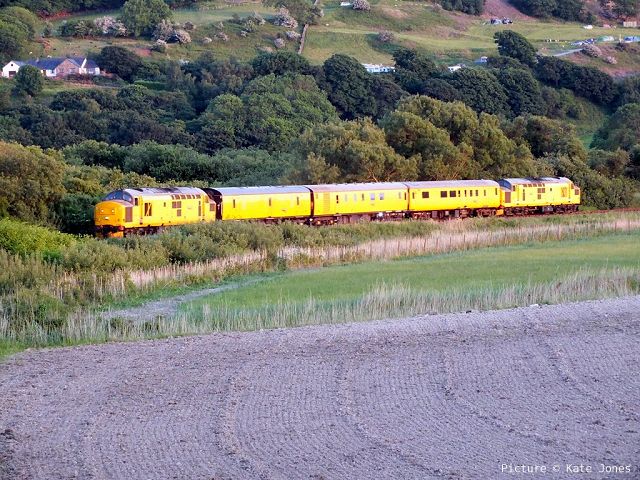
A pair of 97/3 locos on the Cambrian Coast at 21:15 heading north with a measurement train from Machynlleth to Derby Rail Technical Centre via Pwllheli.
To the Airport - with Charlie Hulme
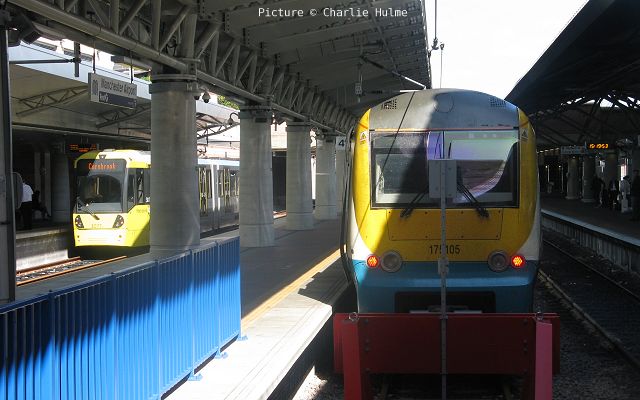
On 2 June I had a chance to sample the newly-enhanced Arriva Trains Wales service to Manchester Airport. At Manchester Oxford Road I boarded train 1H88, 12:53 Llandudno Junction to Manchester Airport, formed of 175 105 which was a couple of minutes late but managed to arrive in recently-opened Platform 4 at Manchester Airport station (above) on time at 15:15. The train called at Manchester Piccadilly and East Didsbury, but the latter place has apparently not been added to the database of the automatic announcer, as on leaving Piccadilly (where many luggage-laden passengers were collected) we were told that the next stop would be Manchester Airport, and East Didsbury was not mentioned at all.
In the background are the Metrolink platforms, with car 3077 waiting to depart for Cornbrook; the Airport service cannot run to the City Centre until the additional route ('second city crossing') opens. Passengers in a hurry to reach Manchester are strongly advised to catch a National Rail train, changing to a tram at Deansgate if the city centre is wanted rather than Piccadilly station. Perhaps this is why the tram does not run right to the end of the platform?
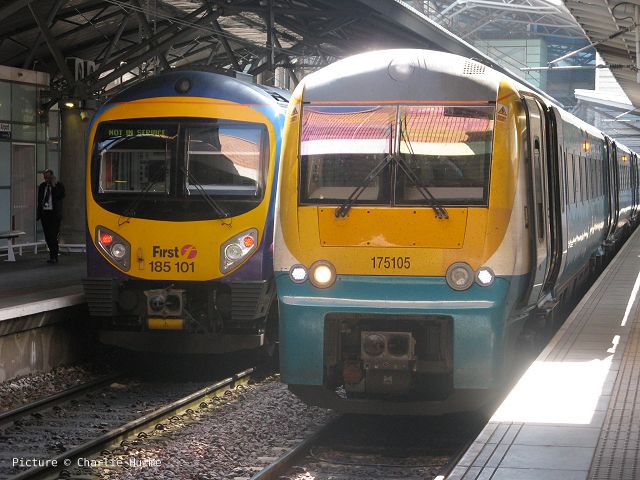
Comparison of front-ends with Siemens-built TransPennine Express unit 185 101. Another train came and went from the far end of Platform 4 before the Arriva service could depart for Llandudno at 15:36, which did happen, despite not being recorded on the Real Time Trains system.
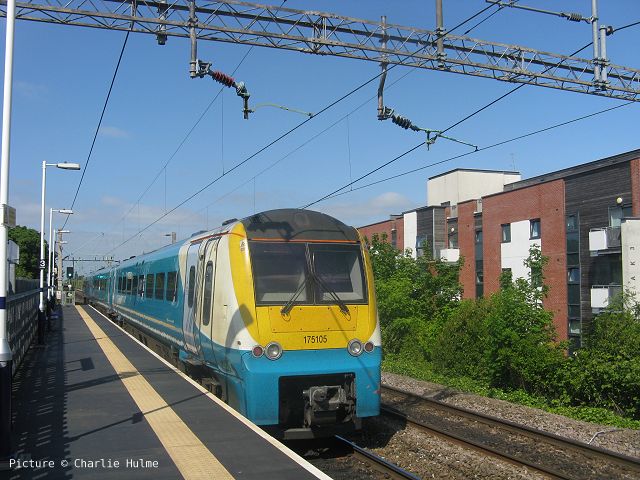
I alighted at East Didsbury (due 15:42), whence the train is seen departing, partly to see if there were any other passengers on offer (non, but one other person got off) and partly in the hope (but not expectation) of photographing the Freightliner from Trafford Park to Southampton (passing time 15:42) - sadly this passed just as the 175 was slowing down for the stop. The stations along here are well-placed to photographed the freights which head hourly out of Trafford Park during the afternoon, as the shadows on the platform confirm.
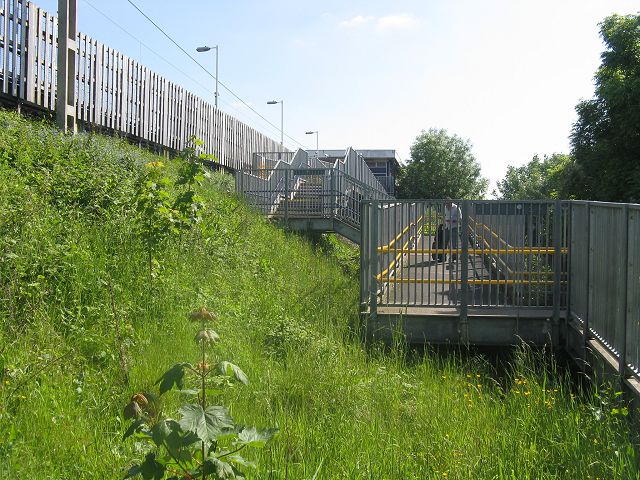
Mauldeth Road, Burnage, East Didsbury and Gatley stations are built on top of embankments adjacent to bridges over roads, and in recent times much work has been done to make them accessible to wheelchair users, etc. without resorting to lifts; East Didsbury has a particularly elaborate construction. There's a a fascinating aerial picture from 1929 on the 'Britain from Above' website showing the area before suburban development spread along the new road 'Kingsway' which had first-generation tram tracks in its central reservation. A tram can be seen near the bottom right of the image.
Out of interest, I decided to walk to East Didsbury Metrolink stop. Although it has the same name as the Northern rail station, it is about ten minutes' walk away. A quiet way to reach it is to follow an un-signed route between the railway embankment and the Tesco superstore (built in the 1980s on the site of Parrs Wood bus garage) and turn right after crossing the tram track. Costa coffee fans might like to know that there is such an establishment inside the Tesco store.
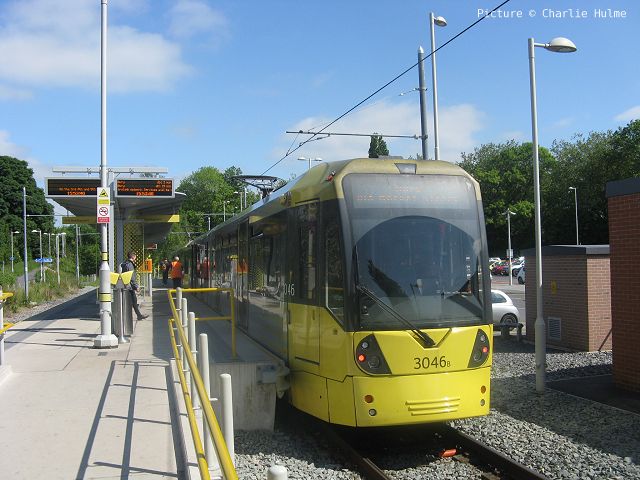
The view above looks towards the end of line as 3046 waits to depart for Rochdale. This section of line occupies the trackbed of a former main line, the Manchester South District Railway (Midland and Great Central Joint) which was part of the route used by Midland Railway trains to and from London St. Pancras. It closed to passengers in 1968 and completely in 1969. There was no railway station at this point: Didsbury's station was close to today's Didsbury Village stop, the first stop for the tram. Just beyond the current end of track is the boundary between Manchester and Stockport: after closure, Manchester Council protected the trackbed, while Stockport's section beyond was abandoned, its cuttings filled in, houses built and bridges destroyed ...
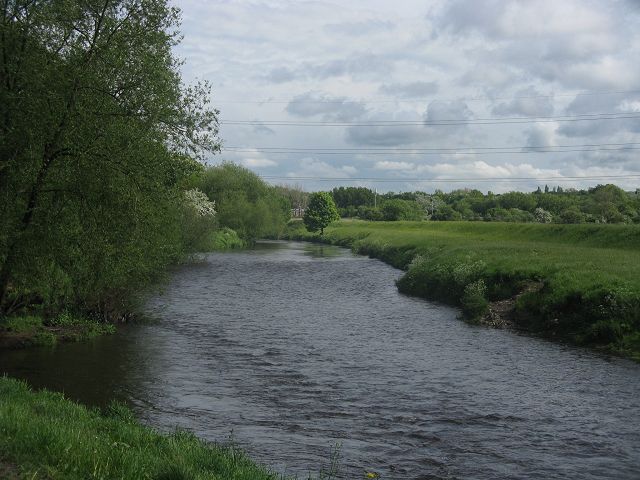
... although it is possible to have a very pleasant walk or cycle ride to Stockport from East Didsbury along the banks of the Mersey as this surprisingly rural view from the path illustrates. In the distance, on the right of this picture behind the flood-bank, runs the surviving single-track line used by freight trains between Hazel Grove High Level Junction and Northenden Junction. There are various proposals to create a tram extension, one of to most unlikely of which involves building a river bridge to allow 'tram-trains' to run beyond East Didsbury to Hazel Grove, but there is no funding on offer at present.
Yellow machines
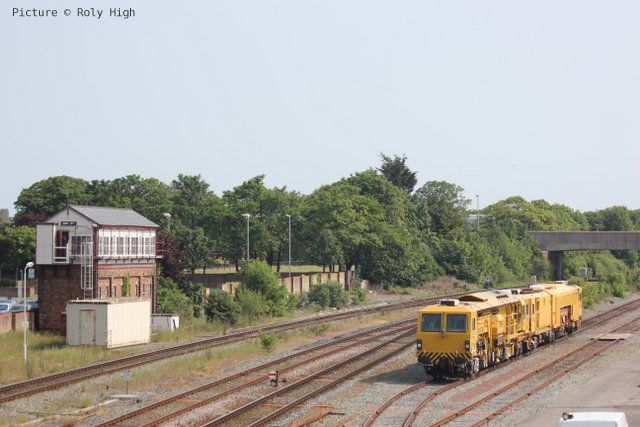
On 6 June at Rhyl, track machines DR 77903 nearest the camera, and DR 73118 in the Engineers Sidings (Roly High). These two are the regular participants in the 'high-output track-relaying' programme that's happening most nights at present.
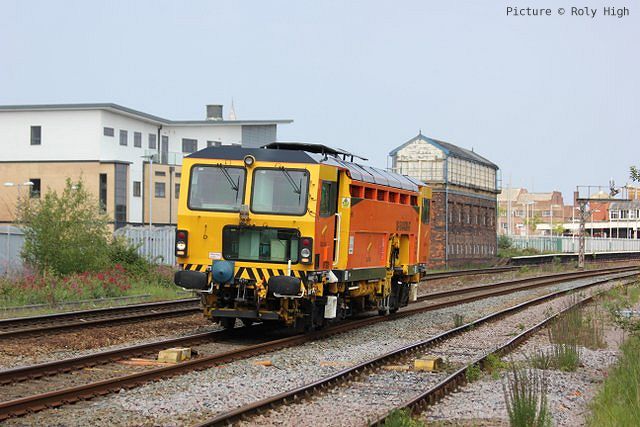
Colas Rail tamper DR 73920 passes Rhyl en route to Bangor from Coleham ISU Engineer's siding in Shrewsbury on 28 May (Roly High).
North Wales Coast home page | Archive | Previous Notice Board